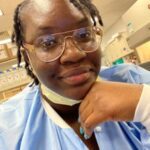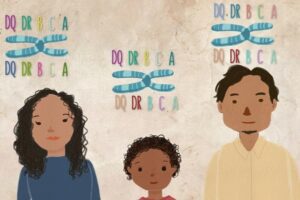Volume 37 Number 1 | February 2023
Ogechi Ohaeto, MLS(ASCP), ASCLS Ascending Professionals Forum Secretary and ASCLS Diversity Advocacy Council Councilor-at-Large

Out of all the stories that were featured in the documentary, two of them caught my attention the most. Imani Cornelius is an adolescent multicultural female who was diagnosed with myelodysplastic syndrome (MDS) back in 2009. She was in desperate need of a bone marrow donation from someone of a mixed-race background. Imani eventually received a bone marrow transplant from someone who is almost a perfect match and was cured of her MDS.

According to the Health Resources and Services Administration, each year 18,000 people might benefit from receiving a life-saving bone marrow transplant2. Now imagine someone of multiethnic background in need of a bone marrow transplant. Unfortunately, the majority of the people who fall in this category do not have a matching donor within their family. Their potential matches are so limited that they may have to seek individuals living outside of the United States just to find a match. This is why it is very important to have people sign up to be bone marrow donors, especially those who are of ethnically diverse backgrounds.
Having people on the registry is not enough, but it’s a start. While watching the documentary, it was sad to learn that 50 percent of the people who are potential matches do not follow through with the process. They either deny the request or ignore their phone calls from the transplant facilities. This makes things even harder for those multiracial individuals who are on the waiting list and already have a small pool to choose from.
The Mixed Match Project featured a woman by the name of Athena Mari Asklipiadi who is of Japanese, Greek, Armenian, Italian, and Egyptian descent. Her foundation, called “Mixed Marrow,” was founded after she recognized the need for multiracial bone marrow. Mixed Marrow is dedicated to finding bone marrow and blood cell donors for patients of multiethnic descent3. Being added to the bone marrow list is easy and painless. All that is required is a cheek swab sample that is tested for the compatibility of Human Leukocyte Antigens (HLA) markers between the donor and the recipient.
The typical age range for bone marrow donors is 18-44; however, individuals 45-60 can still be added to the registry at a cost. The actual bone marrow donation procedure is also a painless procedure that is done in an outpatient setting. The process is done by general or local anesthesia being applied to the pelvic area. This is where liquid marrow is removed from the donor’s pelvic bones with a needle. Donors do not lose anything permanently from this procedure—bone marrow replenishes within a few weeks3.
It is evident that race and ethnicity can be an important factor when it comes to patient care. I believe it is the job of the provider to evaluate each patient on an individual level. We need to recognize and appreciate our diversity. Rather than allow it to divide us, we should embrace it because of the potential importance it may have in our lives.
If you are interested in learning more or becoming a bone marrow donor, please visit mixedmatchproject.com.
References
- Home. Mixed Match Project. (2018, October 23). Retrieved December 1, 2022, from https://mixedmatchproject.com/
- Bone Marrow & Cord Blood Donation & Transplantation. Home | Blood Stem Cell. (n.d.). Retrieved December 1, 2022, from https://bloodstemcell.hrsa.gov/
- About Us. Mixed Marrow. (2017, May 25). Retrieved December 1, 2022, from http://mixedmarrow.org/aboutus
Ogechi Ohaeto is a Medical Technologist II in Microbiology at the University of Florida Health in Jacksonville, Florida.
